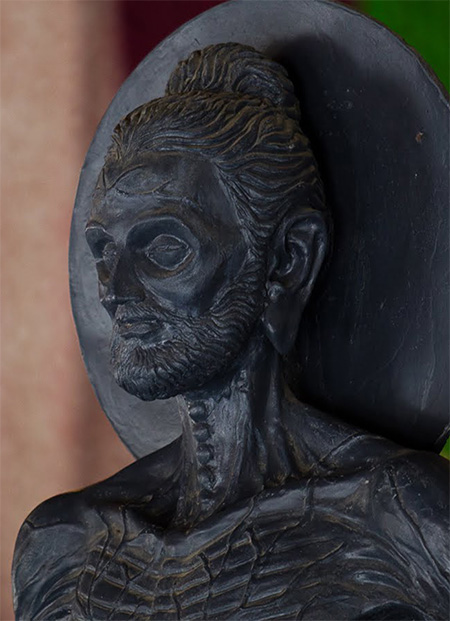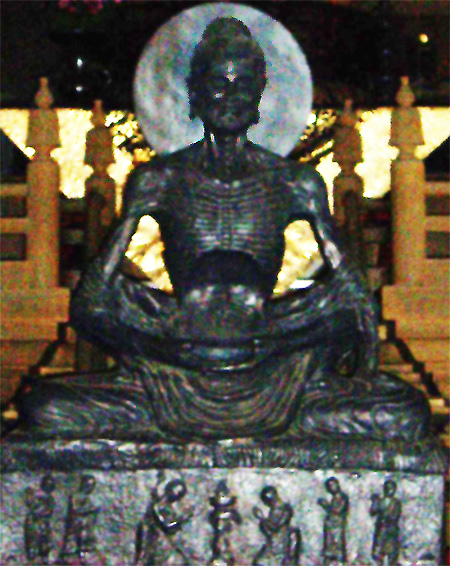


建長寺の創建は1253年。創設者は幕府5代執権・北条時頼。
時代的には京都王権の政治支配が承久の乱によってパワーが衰退し
幕府権力が東国だけではなく全国に拡張した鎌倉幕府絶頂期。
頼朝による武家権力の創始から70-80年経過した時期に当たる。
幕府の滅亡が1333年なので約150年の期間のほぼ半ば。
そういう時代相のなかで武家としての新時代仏教として禅宗が
最新の中国仏教として導入されていったとされる。
開山者には中国からの渡来僧・蘭渓道隆が選択され伽藍配置も中国式とされた。
寺院内では中国語が公用されていたという。
武家権力としては畿内地域の「伝統的」仏教思想に対して
新時代の「国家鎮護」思想を持って統治すると宣言したかったのか。
権力の安定期でもあり北条時頼は熱心な仏教信者であったとされる。
権力が安定してくると統治の平和的浸透のために宗教を利用する考えが
主導的になってくるのが必然の流れなのかも知れない。
前回まで触れてきた歴史の流れで言えば平泉の藤原政権では
創始者の藤原清衡自身が中尊寺の「願文」を残している。
日本史では平泉と奥羽の情勢はメインカレントとは見なされず、
京都中央での源平の興亡が主流のように描かれていくけれど、
武家政権の萌芽はむしろ奥羽での戦乱がその端緒にあたり、
そこでの血みどろの戦争状況が国内情勢の最先端に盛り上がっていって
結果として「関東国」という新国家が全国統一したといえるのではないか。
そもそも関東の開墾地主層が武士「階級」の基盤であり、
かれらが京都中央での「武家貴族」源氏(頼朝にいたる嫡流)を推戴利用し
征夷大将軍という中央からの独立的権力根拠を獲得し
鎌倉に全国の権力を集中させたのが日本史の実相だと思える。
京都政界での得体の知れない宮廷貴族たちの主導権争いという実態から
よりリアルな政治基盤に主役を転換していったという流れ。
そのようななかで基盤を確立させた開墾地主の盟主・北条家は
自らの権力に装飾性を持たせるのに、こうした禅宗を選択した。
この鎌倉での寺院建築に「建長」という年号名を付したのは
武家政権の揺るぎない正統性・基盤を象徴させたと思える。
そうした武家の世の寺院として選択されたのが、禅宗。
それまでの仏教宗派に対し「個人」としての克己心に着目していると思える。
武家という存在は命のやり取りをする役割を担っているので
常に生死の境を意識し続ける存在でもある。
もちろん自らの生死を賭けるとき、その個人の上位概念として
いわば「法人」としての家、家系意識があってその利益のために
自分一個の生命をやり取りするという心象世界を持っている。
そういったかれらにとって、禅の説く精神性がふさわしく感じられたのか。
建長寺で見た仏像群のなかで特徴的と思われたのが写真の「仏陀苦行像」。
仏教の創始者であるゴータマブッダさんが悟りを得るのに修行時、
食も取らずに骨が浮き出るほど一心不乱に修行していた様子を
このような仏像に活写してそれを武家たちは拝跪していた。
禅宗寺院が武家に支持されたのには、こういった自分たちの生き様死に様に
もっともその教えがふさわしいと思えたのではないか。
English version⬇
[The inner world and religion of the samurai who lead the era Kenchoji Kamakura-5]
Kenchoji Temple was founded in 1253. The founder is Hojo Tokiyori, the fifth shogunate.
In the era, the political rule of the Kyoto kingship declined due to the Jokyu War.
The heyday of the Kamakura Shogunate, when the power of the Shogunate expanded not only to the eastern country but to the whole country.
It is 70-80 years after Yoritomo’s founding of samurai power.
Since the shogunate was destroyed in 1333, it was almost the middle of the 150-year period.
Zen Buddhism as a new era Buddhism as a samurai in such an era
It is said that it was introduced as the latest Chinese Buddhism.
Lanxi Daolong, a monk from China, was selected as the founder, and the cathedral arrangement was also Chinese style.
It is said that Chinese was officially used in the temple.
As a samurai power, against the “traditional” Buddhist thought of the Kinai region
Did you want to declare that you would rule with the idea of ”national protection” in the new era?
It is said that Hojo Tokiyori was an avid Buddhist believer during the stable period of power.
The idea of using religion for the peaceful penetration of governance as power stabilizes
It may be an inevitable flow to become a leader.
Speaking of the history that I touched on until the last time, in the Fujiwara administration of Hiraizumi
The founder, Kiyohira Fujiwara himself, has left behind the “request” of Chusonji Temple.
In Japanese history, the situation in Hiraizumi and Ou is not considered the main current,
The rise and fall of Genpei in central Kyoto is depicted as if it were mainstream,
The sprouting of the samurai government started with the war in Ou,
The bloody war situation there was rising to the forefront of domestic affairs.
As a result, it can be said that the new nation called “Kanto” has been unified nationwide.
In the first place, the landowners in the Kanto region are the foundation of the samurai “class”.
They used the “samurai aristocrat” Genji (a pedestrian style leading up to Yoritomo) in central Kyoto.
Acquired an independent basis of power from the central government, the Shogun General
It seems that the fact of Japanese history is that the power of the whole country is concentrated in Kamakura.
From the fact that the unfamiliar court aristocrats are fighting for the initiative in Kyoto politics
The flow of shifting the leading role to a more realistic political base.
Under such circumstances, the Hojo clan, the lord of the landowner who established the foundation,
I chose these Zen sects to give my power a decorative touch.
The name of the temple building in Kamakura was named “Kencho”.
It seems to have symbolized the unwavering legitimacy and foundation of the samurai government.
Zen Buddhism was selected as the temple of the samurai world.
It seems that he is paying attention to his selfishness as an “individual” with respect to the Buddhist denominations up to that point.
Because the existence of a samurai plays a role in exchanging lives
He is also always aware of the boundary between life and death.
Of course, when betting on one’s life or death, as a superordinate concept of that individual
So to speak, for the benefit of having a family consciousness as a “corporation”
I have a mental world of exchanging one’s own life.
Did they feel that the spirituality that Zen preached was appropriate?
Among the Buddhist statues I saw at Kenchoji Temple, the one that seemed to be characteristic was the “Buddha penance statue” in the photo.
When Gautama Buddha, the founder of Buddhism, trained to gain enlightenment,
It seems that he was practicing so hard that his bones emerged without eating.
The samurai were worshiping it by copying it live on such a Buddha statue.
The reason why Zen Buddhist temples were supported by the samurai was that they lived and died.
I think that teaching seemed appropriate.
Posted on 12月 20th, 2021 by 三木 奎吾
Filed under: 住宅マーケティング, 日本社会・文化研究, 歴史探訪







コメントを投稿
「※誹謗中傷や、悪意のある書き込み、営利目的などのコメントを防ぐために、投稿された全てのコメントは一時的に保留されますのでご了承ください。」
You must be logged in to post a comment.